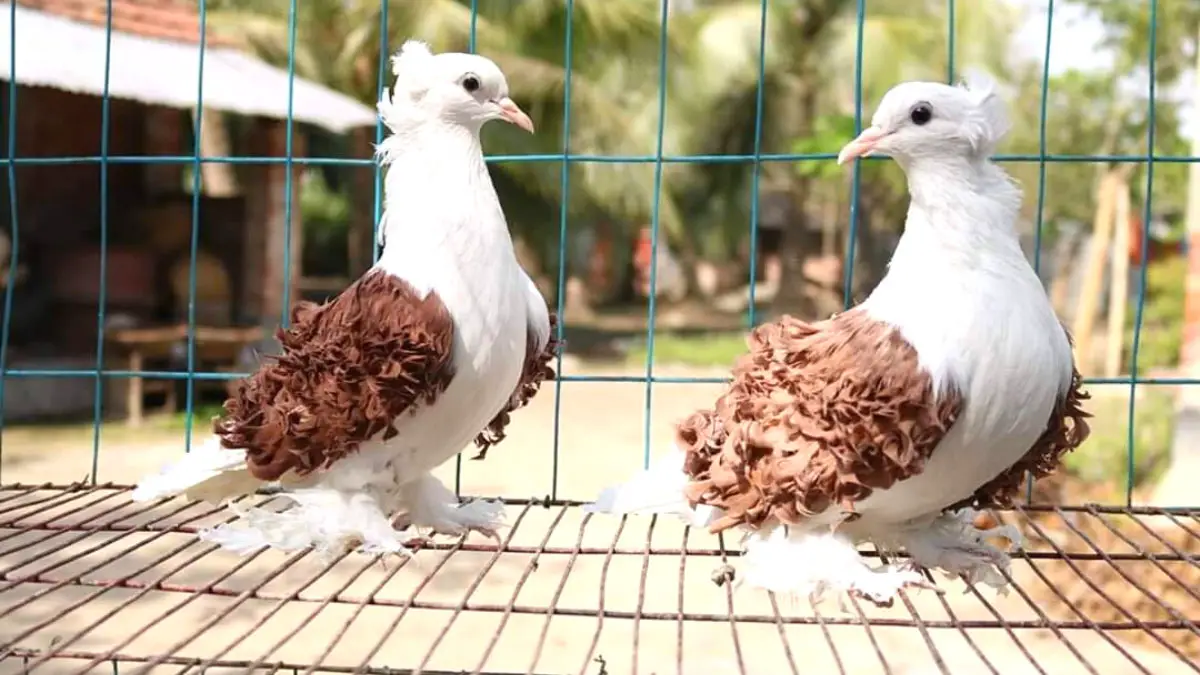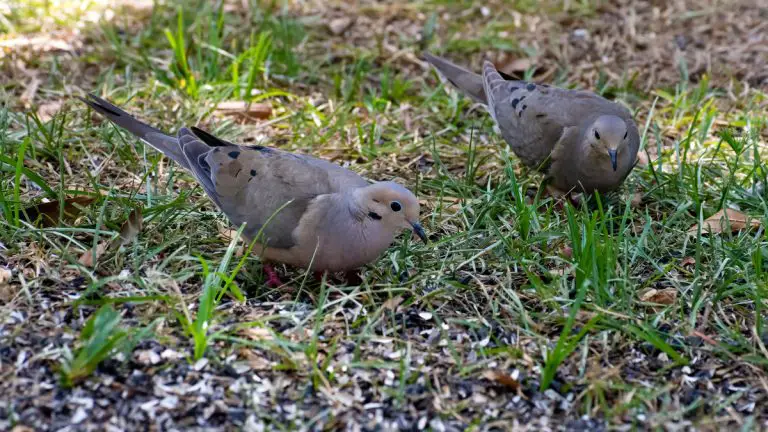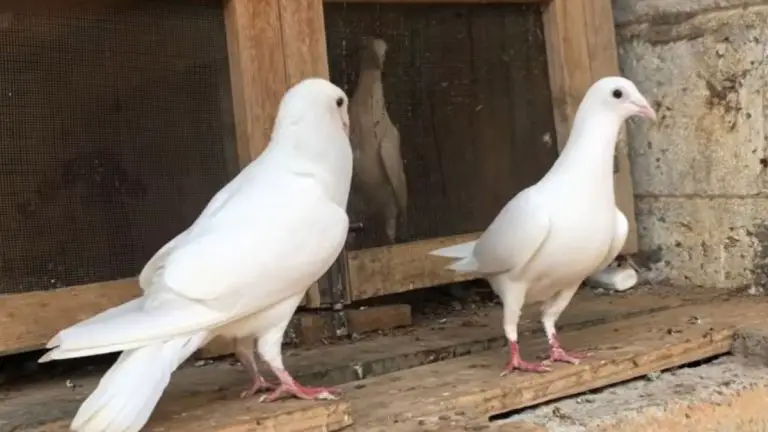Frill Back Pigeon: Origin, Appearance, Behavior, Care, And More
The Frill back pigeon looks exactly as its name sounds; it’s covered by frill feathers on its back. The distinctive curly feathers make this breed one of the fanciest and most coveted domesticated pigeons across the globe. Not to forget it’s one of the highest prized breeds in pigeon beauty contests!
This article will give you more in-depth details about the frillback pigeon. You’ll discover how the pigeon came to be and its origin, its list of unique physical characteristics, behavior, and temperament. If you’re planning to get this bird as a pet, we’ll give you tips on how to take care of it in terms of diet, housing, healthcare, and more!
Frill back Pigeon Quick Facts:
| Scientific name | Columba livia domestica |
| Other names | Lockentauben (German) |
| Breed name | Frill back |
| Origin | Asia |
| Breed purpose | Exhibition, ornamental, pets |
| Size | Medium |
| Weight | Around 400 grams |
| Flying ability | Average |
| Cost | $50 to $150 |
| Lifespan | Around 10 years |
Origin and history
The exact origin of the frill back pigeon is unknown but it’s believed to have come from the ancient region of Asia Minor.
This area also goes by the name Anatolia and corresponds to the region covering present-day Greece, Turkey, Armenia, Kurdistan, and Assyria.
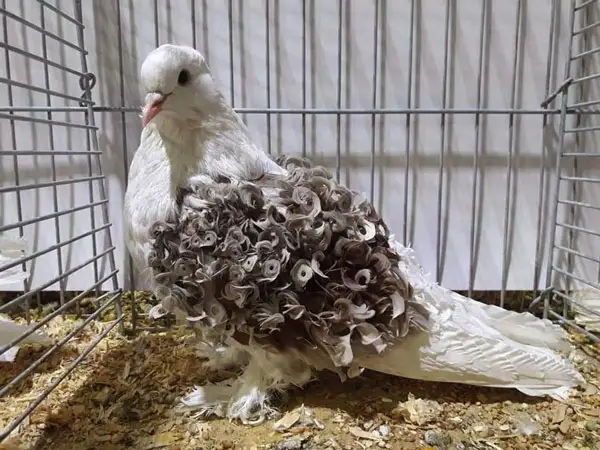
Like most domesticated pigeon breeds, the frillback is a product of many, many years of selective breeding. And it’s a descendant of the rock pigeon (Columba livia).
The bird gets its name from the curls and frills on its windshield feathers. These curly feathers are also present at the ends of the bird’s foot feathers.
Keep in mind that frill back is an ancient pigeon breed. This is supported by the act that it’s one of the pigeons that Charles Darwin kept as a pet. (Source).
Today, the bird is highly regarded as a show bird, including in the US.
Appearance
The Frillback pigeon is medium-sized and appears slightly larger than most colored domesticated pigeons.
Needless to mention, the most distinctive feature of this bird is the frill feathers on its back which appear like small and crimped feathers.
Another distinctive feature is the muffs or feathers covering their feet, in addition to distinct rigged feathers near the wing tips and on the tail. The bottom of the muffs is also frilled.
Feathers around the bird’s head appear distinctly separated.
Note that frillback pigeons have either a plain or shell-crested head. The later varieties feature a thick shell crest on the head back with rosettes on both sides. The crest itself stands off the head.
Plain-headed varieties, however, feature slightly oval head shapes and no flat areas. The forehead has a distinct stop around the wattle.
Frillback pigeon has its eyes falling in line with the beak. All the breed varieties have reddish-orange eye color, save for the shield-marked variety which features blue or black eyes.
The bird has a long beak, with the upper beak appearing slightly longer than the lower one. The beak color is usually dark on blue and red grizzles, light on yellow, black on black, and so on.
As with most pigeon breeds, frillback pigeons come in many color variations. The most common varieties include black, white, red grizzle, blue griddle, yellow grizzle, and silver grizzle.
The video below shows some of the most common color patterns in frill backs
Video:
Behavior
The pigeon is generally nervous and flighty. Generally, the temperament can vary from individual to individual, so some frill backs may be calm and friendly.
That said, the German variety tends to show a relatively calm temperament compared to the American breed and doesn’t seem to be easily upset by anything.
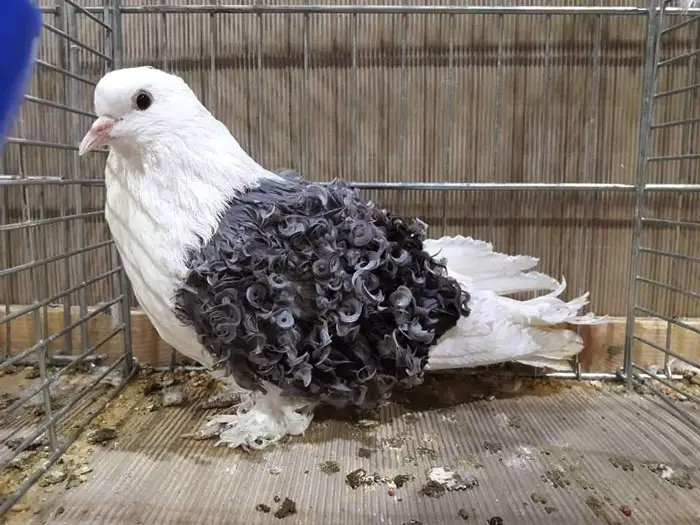
The best way to ensure your bird is tame is consistent handling and even hand raising from a young age.
For show birds, exposing them to show cages from a young age can also help keep the bird from getting stressed at shows and give the judges a hard time.
While these birds can still fly, their curly feathers limit their flying ability, so they prefer walking more than flying.
Diet
Frill backs diet should be made up of a mixture of a variety of seeds and grains such as safflower, milo, paddy, wheat, corn, barley, etc.
Fresh vegetables and fruits that are non-toxic for the birds can also be fed to them to help add nutritional value to their diet.
As for the feeding frequency, you should give your pigeons food twice every day. And each session should have an amount of food the bird can finish in about 20 minutes.
You should also give your frillbacks fresh and clean water every day.
Frill back pigeons as pets
If you decide to keep these birds as pets, make sure you provide them with proper care to keep them healthy.
Good care also enables them to maintain their frill feathers and other distinct features.
House them in a spacious enclosure so they have plenty of room to move around and exercise. Additionally, make it airy, include perches, and secure it from harsh elements and predators.
Don’t forget to clean it every day. A hygienic environment translates to healthy birds.
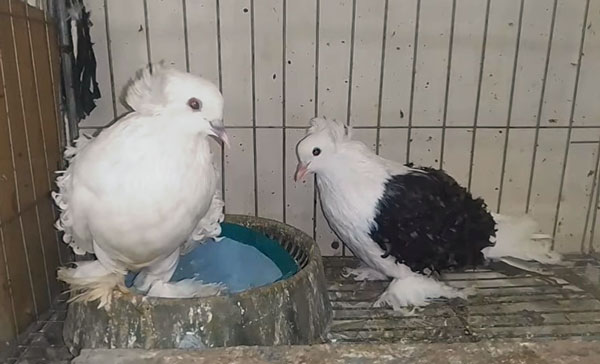
You should also ensure you feed your birds a healthy and balanced diet that comprises a variety of seeds and grains (check our previous section for more details on how to feed your bird a balanced diet).
Grooming your frillbacks is also part of taking good care of them and will help ensure they stay in tip-top condition. This is especially important if you plan to raise these birds for shows.
Regular vet checkups are also necessary to ensure the birds stay healthy.
Frill back as a show pigeon
However, there are some simple preparations tips you can follow before the show to keep in tip-top condition as outlined below:

- Use something as simple as a wooden popsicle stick to help you gently comb and lift the feathers off the bird’s body.
- For white birds, it goes without saying that you’ll need to clean soiled tails and muffs.
- As per breed standards, you can pluck any misplaced colored feathers, e.g. white feathers on a blackbird.
- Keep black birds out of direct sunlight to prevent bleaching.
- Trim excessive beaks and nailing by simply filing them.
- We advise you to remove bathwater from your bird’s enclosure a few days before the show. This trick will help restore the feathers’ bloom.
- If your bird features a crest, then you can simply shape it with your fingers as necessary.
Breeding guide for frill back pigeons
Breeding frillbacks is easy when you have some background info about the whole process.
Frillbacks are generally not known to build a nest, so it’s upon you to provide them with a nesting box with suitable nesting materials.
Also, some of these birds make great parents while others may require the help of a feeder.
When you get down to breeding your birds, expert breeders advise you to identify the base color in your loft and note it down.

There are 3 primary bases namely red, blue, and brown. In addition, there are numerous modifiers that act on these bases.
You should with the highest-quality bird possible, especially if you want results fast.
However, if you’re patient enough to build your bloodline slowly, then you’d want to ensure you start with not the best, but the very best.
It’s also a good idea to get high-quality unrelated birds from reputable breeders around to help increase the quality of birds in your loft.
If you keep breeding your related birds, you’ll be promoting inbreeding problems in your loft.
One more thing, avoid excessively breeding your backfills as this can make them get easily stressed and upset.
Frill back pigeon price
You should expect to spend between $50 and $150 depending on a variety of factors such as the bird’s quality, lineage, age, sex, and location.
The demand for frillbacks is high in America but there are not many breeders, leading to high costs for these birds.
High-quality birds with show standard qualities also sell at higher prices.
If you get lucky enough, you may find a pigeon fancier willing to give you a pair to start with on the condition that you’ll join an American frillbacks club.
Lifespan
Frillback pigeons have a long lifespan of around 10 years when properly cared for. However, their life can be easily cut short by poor diet, malnutrition, poor living conditions, lack of exercise, and so on.
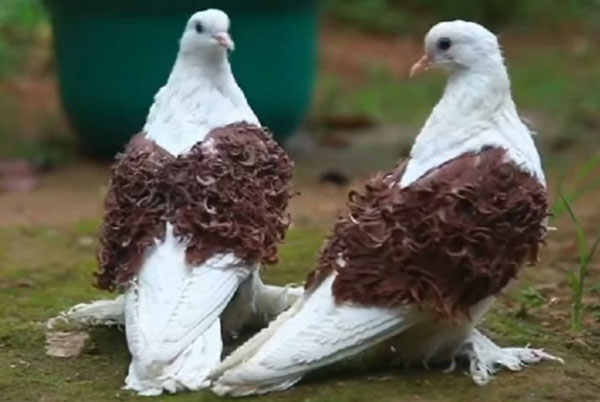
That said, you can help extend your pigeon’s lifespan by giving it a balanced and healthy diet, ensuring it stays in a hygienic and spacious enclosure with plenty of room for exercising, and having it routinely checked by an experienced vet.
If you’re interested in learning more about different breeds of pigeons, you might find our articles on ice pigeons and giant runt pigeons helpful. Our article on ice pigeons provides an in-depth look at the history, characteristics, and care of these unique birds, while our article on giant runt pigeons explores another fascinating breed known for its size and beauty.Final Verdict
The frill back’s unique appearance marked by curly feathers on its back makes it a popular breed for ornamental and exhibition purposes. Additional distinct features that make the bird stand out include long feathers and tail, muffs, crest on its head, and multiple color varieties.
This bird is also ideal for raising as a pet. But it requires proper care to keep it happy and healthy. Follow the tips we’ve discussed in the above guide on how to take good care of your frill back pet and it will give you companionship for many years to come.
